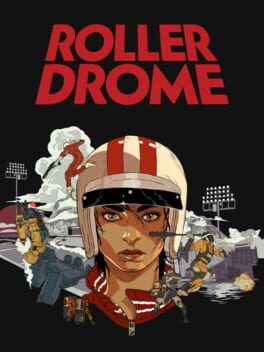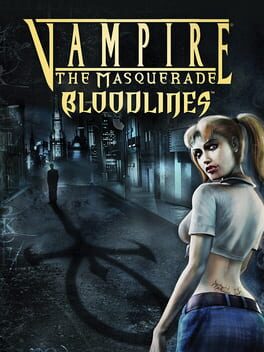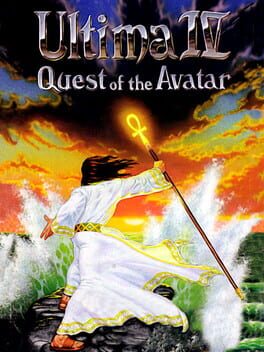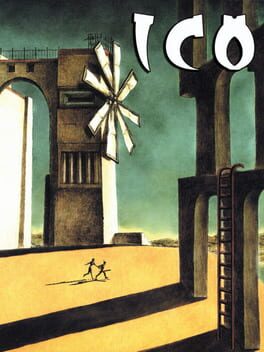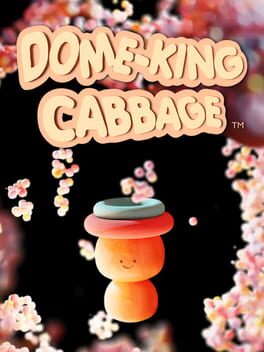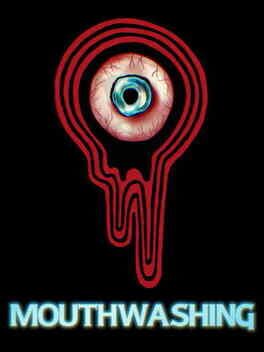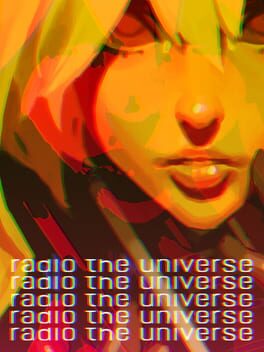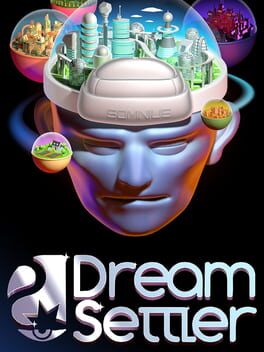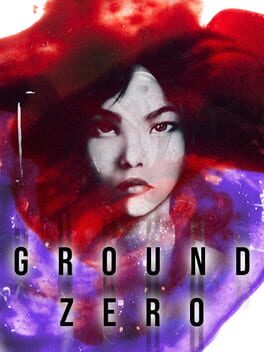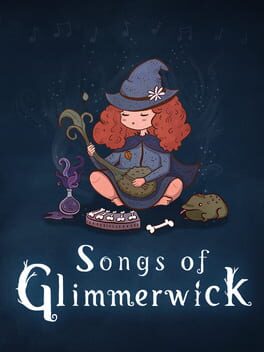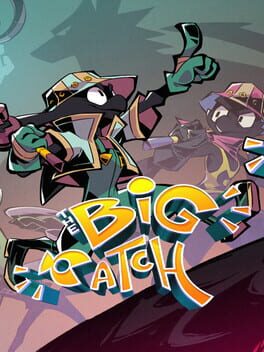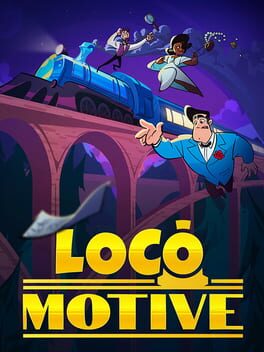MaggotBrain
3 reviews liked by MaggotBrain
Rollerdrome
2022
I actually beat Rollerdrome back in March and was quite enamored at first, but I've since cooled down on it somewhat. A quick replay today has only confirmed my suspicions that there's unfortunately a lot left to be desired. Feel free to take my word here with a grain of salt: I'm not a particularly huge Tony Hawk fan and was more or less playing this as part of a warm-up via Jet Set Radio-likes (since Bomb Rush Cyberfunk is coming out in less than a week, and I replayed the original Jet Set Radio right before this). Still, if I had to put my finger on why this didn't hit the mark the second time around, my best guess would be that Rollerdrome doesn't understand how to create an engaging difficulty curve, and here are some of my theories as to why:
- Progression: Rollerdrome locks its stages behind completing challenges (collect all the tokens, do a certain trick while killing a certain enemy, rack up enough points, etc), with ten challenges per stage and sixty completed challenges required to unlock the finals. This is supposed to incentivize players to tackle as many challenges as possible while going through stages, but in reality what I found myself doing was farming the earlier stages for the easiest challenges to get the base completion requirement out of the way, and throwing away dry runs to farm the more manageable challenges at the beginning before resetting and running through the stages proper. This unfortunately feels like an artificial implementation of coercing me to explore its mechanics when I was usually more concerned with straight efficiency regarding combat.
- Tricks: You need to perform tricks constantly in Rollerdrome to restore your ammo, and tricks are also a way to quickly rack up points in-between shooting to exploit your current combo multiplier. Again though, I found tricks to be unnecessarily complicated and superfluous outside of doing the required tricks to complete necessary challenges: if you don't care about your score, then all you have to do for quick ammo restoration is to just hold the stick forward and perform the same grab/flip/spin while not in combat, or just spend your time grinding on rails/edges and firing since you'll automatically regain ammo for grinding up to a certain point. It also doesn't help that I found the inputs for more complex tricks a bit fiddly and perfect dodges refresh some of your ammo anyway, reducing the reliance upon tricks. Speaking of which...
- Dodge/Super Reflex: The dodge is a little too good in Rollerdrome. You can basically invincible frame roll at any time in the game (including in mid-air and while grinding), outside of a few frames right after the roll animation ends as far as I can tell. This not only provides a reliable method for quickly getting out of danger, but also you can roll in any direction to quickly alter your momentum and enter Super Reflex if you activate bullet-time right as you perfect dodge (that is, dodging in the first few frames of an active enemy attack). To summarize, this strategy easily gets you ammo refills, allows for relative invincibility when confronted by a barrage of attacks, and powers up your shots while in Super Reflex, which as a result makes Rollerdrome almost feel too reactive as opposed to proactive since it's far too advantageous to not abuse this to safely and quickly wipe out waves.
- Stages: Rollerdrome only has 11 stages, and quite a few of these stages are just repeated locales with few hazards outside of the enemies and a lot of empty, open space outside of a few trick ramps and grind rails/edges. A bit more variety in the set design (and more walls to wall-ride, which I thought was a little underutilized) would have been appreciated since by halfway through, some of the arenas started to bleed into one another for me.
- Laser: I'm fine with most of the weapon balance in Rollerdrome, but the Z-11 (the in-game laser gun) is an exception. The main caveat to using the Z-11, aside from the three shot capacity (still more than the grenade launcher though), is that you can't use aim assist to automatically lock on to foes with it and thus must manually point your reticle at them. Not a very difficult task though, since Reflex gives you more than enough reaction time and the reticle turns red as soon as you hover over a target. Because the shotgun and pistol are limited somewhat by range for aim assist (especially the shotgun due to perfect slug shots), the laser is a godsend: it bypasses this system entirely and lets you snipe foes from across the arena, taking out most enemies after a double charge and can also pierce through multiple enemies at a time. It further disrupts this balance because the Z-11 is unlocked halfway through, meaning the game's earlier combat/combo challenges are a lot more difficult without it at first but often rather trivial once you've unlocked it.
- Boss fights: I've already mentioned that Rollerdrome's dodge roll is a bit overcentralizing, but nowhere does this become more evident than during the two boss fights, shifting the prevailing strategy from any semblance of ammo management/route planning to just basic bait and punish. Simply wait for enemy attacks, dodge to regain ammo/enter Super Reflex to finish off goons, and then approach the big robot to deal damage and enter the next phase. There's no scoring optimization or crazy tricks/maneuvering involved, and as a result, these tend to be pretty dry affairs that could have been removed from the game entirely with little value lost.
I certainly get the appeal of Rollerdrome, given its potential for optimization to maximize the combo meter and quickly speedrun stages, but unfortunately I find that the game doesn't get harder, but rather gets longer with more enemies that take more hits and throw out more attacks. Even so, I had enough fun constantly filling foes with lead in slow-mo, but even this thrill began to wear itself thin an hour in. I can't help but feel that the separate movement and combat mechanics are undercooked despite how promising "Tony Hawk with bullet-time gunplay" sounds on paper. More power to those who find the core gameplay engaging enough to try and complete all the challenges + the "Out for Blood" post-game replay with stricter margins: as for me, I'm content with putting this down after a few hours and completing Finals with a C rank. Rollerdrome is by no means a bad game, but I know Roll7 is capable of so much more.
- Progression: Rollerdrome locks its stages behind completing challenges (collect all the tokens, do a certain trick while killing a certain enemy, rack up enough points, etc), with ten challenges per stage and sixty completed challenges required to unlock the finals. This is supposed to incentivize players to tackle as many challenges as possible while going through stages, but in reality what I found myself doing was farming the earlier stages for the easiest challenges to get the base completion requirement out of the way, and throwing away dry runs to farm the more manageable challenges at the beginning before resetting and running through the stages proper. This unfortunately feels like an artificial implementation of coercing me to explore its mechanics when I was usually more concerned with straight efficiency regarding combat.
- Tricks: You need to perform tricks constantly in Rollerdrome to restore your ammo, and tricks are also a way to quickly rack up points in-between shooting to exploit your current combo multiplier. Again though, I found tricks to be unnecessarily complicated and superfluous outside of doing the required tricks to complete necessary challenges: if you don't care about your score, then all you have to do for quick ammo restoration is to just hold the stick forward and perform the same grab/flip/spin while not in combat, or just spend your time grinding on rails/edges and firing since you'll automatically regain ammo for grinding up to a certain point. It also doesn't help that I found the inputs for more complex tricks a bit fiddly and perfect dodges refresh some of your ammo anyway, reducing the reliance upon tricks. Speaking of which...
- Dodge/Super Reflex: The dodge is a little too good in Rollerdrome. You can basically invincible frame roll at any time in the game (including in mid-air and while grinding), outside of a few frames right after the roll animation ends as far as I can tell. This not only provides a reliable method for quickly getting out of danger, but also you can roll in any direction to quickly alter your momentum and enter Super Reflex if you activate bullet-time right as you perfect dodge (that is, dodging in the first few frames of an active enemy attack). To summarize, this strategy easily gets you ammo refills, allows for relative invincibility when confronted by a barrage of attacks, and powers up your shots while in Super Reflex, which as a result makes Rollerdrome almost feel too reactive as opposed to proactive since it's far too advantageous to not abuse this to safely and quickly wipe out waves.
- Stages: Rollerdrome only has 11 stages, and quite a few of these stages are just repeated locales with few hazards outside of the enemies and a lot of empty, open space outside of a few trick ramps and grind rails/edges. A bit more variety in the set design (and more walls to wall-ride, which I thought was a little underutilized) would have been appreciated since by halfway through, some of the arenas started to bleed into one another for me.
- Laser: I'm fine with most of the weapon balance in Rollerdrome, but the Z-11 (the in-game laser gun) is an exception. The main caveat to using the Z-11, aside from the three shot capacity (still more than the grenade launcher though), is that you can't use aim assist to automatically lock on to foes with it and thus must manually point your reticle at them. Not a very difficult task though, since Reflex gives you more than enough reaction time and the reticle turns red as soon as you hover over a target. Because the shotgun and pistol are limited somewhat by range for aim assist (especially the shotgun due to perfect slug shots), the laser is a godsend: it bypasses this system entirely and lets you snipe foes from across the arena, taking out most enemies after a double charge and can also pierce through multiple enemies at a time. It further disrupts this balance because the Z-11 is unlocked halfway through, meaning the game's earlier combat/combo challenges are a lot more difficult without it at first but often rather trivial once you've unlocked it.
- Boss fights: I've already mentioned that Rollerdrome's dodge roll is a bit overcentralizing, but nowhere does this become more evident than during the two boss fights, shifting the prevailing strategy from any semblance of ammo management/route planning to just basic bait and punish. Simply wait for enemy attacks, dodge to regain ammo/enter Super Reflex to finish off goons, and then approach the big robot to deal damage and enter the next phase. There's no scoring optimization or crazy tricks/maneuvering involved, and as a result, these tend to be pretty dry affairs that could have been removed from the game entirely with little value lost.
I certainly get the appeal of Rollerdrome, given its potential for optimization to maximize the combo meter and quickly speedrun stages, but unfortunately I find that the game doesn't get harder, but rather gets longer with more enemies that take more hits and throw out more attacks. Even so, I had enough fun constantly filling foes with lead in slow-mo, but even this thrill began to wear itself thin an hour in. I can't help but feel that the separate movement and combat mechanics are undercooked despite how promising "Tony Hawk with bullet-time gunplay" sounds on paper. More power to those who find the core gameplay engaging enough to try and complete all the challenges + the "Out for Blood" post-game replay with stricter margins: as for me, I'm content with putting this down after a few hours and completing Finals with a C rank. Rollerdrome is by no means a bad game, but I know Roll7 is capable of so much more.
Pikmin
2001
I think the modern gamer has a tendency to outright dismiss a game's larger worth as a piece of art if it doesn't match a specific ideal of gameplay and presentation. Pikmin is not exactly what I'd consider a pretty game in all respects (there are certainly a few aspects that were technically impressive at the time though), and its gameplay experience seems purposefully tumultuous as much it attempts to simplify the RTS formula down in the typical Miyamoto fashion. But Pikmin is still a beautiful piece of art all the same, is it not?
I first played Pikmin in my teens, and I think it might've been the first game to teach me two things about games as a medium: that friction (and consequences) within a gameplay experience can be meaningful and compelling in its own right, and that a game can be more than the sum of its parts. It's actually kind of cool that the Pikmin AI will sometimes not listen or do something absolutely stupid; the things that modern gamers find annoying are part of what made Pikmin special.
Sure, Pikmin 2 is filled to the brim with content, and Pikmin 3 is a more realized and polished mechanical experience (I am not disparaging either of those games, I love them as well), but Pikmin has the most heart both in how its mechanics force you to think about your time and resources, and in how its narrative is more personal and dire. The bad, neutral, and good endings of Pikmin all stick with you.
Pikmin taught me that failure is okay, at least in the abstract gameplay sense. Olimar may have perished or even just returns home with no fanfare, but the player has another chance to do it better the next time. It's not a particularly hard game, but I do think it's an oft misunderstood game, so I just wanted to give this incredible little game the love it deserves.
I first played Pikmin in my teens, and I think it might've been the first game to teach me two things about games as a medium: that friction (and consequences) within a gameplay experience can be meaningful and compelling in its own right, and that a game can be more than the sum of its parts. It's actually kind of cool that the Pikmin AI will sometimes not listen or do something absolutely stupid; the things that modern gamers find annoying are part of what made Pikmin special.
Sure, Pikmin 2 is filled to the brim with content, and Pikmin 3 is a more realized and polished mechanical experience (I am not disparaging either of those games, I love them as well), but Pikmin has the most heart both in how its mechanics force you to think about your time and resources, and in how its narrative is more personal and dire. The bad, neutral, and good endings of Pikmin all stick with you.
Pikmin taught me that failure is okay, at least in the abstract gameplay sense. Olimar may have perished or even just returns home with no fanfare, but the player has another chance to do it better the next time. It's not a particularly hard game, but I do think it's an oft misunderstood game, so I just wanted to give this incredible little game the love it deserves.
The biggest video game mystery of the past decade. It's the most groundbreaking, medium-redefining experience of our generation - and nobody can explain why. I'm convinced this is all a conspiracy orchestrated by YouTube video essayists. The promise (yet unfulfilled) of The Great Open World Video Game blinds us to the fact that we've seen all of this many times before.
Fundamentally, Breath of the Wild is a pastiche of the safest, most focus-tested game design principles of the preceding decade. You could call it the 'Tower' type game. Climb a tower to unlock a new area on your map, which will reveal the repeatable skinner box activities you can complete there. Puzzles, dungeons, enemy camps, the usual. These activities give you something like XP, increased health, or a new item, which account for progression. Once you're done, you climb another tower and repeat the process until you're ready to fight the final boss (or more likely, until you're bored and ready to rush to the game's end).
That's the gameplay loop. And like every single other one of these games ever made, the loop eventually becomes a dull grind. Breath of the Wild does nothing to solve this problem endemic to open world games. Some have praised the game's traversal, which, other than shield surfing (which is cool to be fair), is really just climbing walls, riding a horse, using a glider, or fast travelling; the same traversal methods in Assassin's Creed: Brotherhood, released seven years earlier (Shadow of the Colossus is also a clear influence). Really I would challenge anyone to explain how Breath of the Wild is a masterpiece while Assassin's Creed is a soulless corporate product. You're playing the same game. What's the difference besides some nice vibes and a cell-shaded art style? Grass? At least Assassin's Creed has that cyberpunk meets ancient aliens meets secret societies meets historical fiction bullshit made up by French people. That's creativity.
Proponents of the game may praise the Shiekah slate physics abilities as an innovation, and that feels true at first. But eventually your enemies become too powerful for hitting them with rocks or whatever to do a thing; you'll need to use some bullshit level-scaled RPG weapon. And even if the Shiekah slate remained effective in combat, you would still end up doing this. Why? Because this game has so much dull, repeated content to wade through that it becomes easier to take the path of least resistance, the least thought required, and just hit them with your sword. 30 hours in, no player is using cool Shiekah slate tricks to clear those regenerating bokoblin camps.
Much discussion has already been had on the monotony of the 120 copy-pasted shrines, which make up the bulk of the game's content (its version of the side tasks from Assassin's Creed), and the 900 copy-pasted korok seed puzzles, which act as the collectibles obligatory of every Tower game. I won't rehash that too much here, copy-pasted content is already the most common criticism of open world games in general. But knowing that, I want to talk about something I've noticed with a lot of the praise for this game.
Some of the most common sentiments expressed toward Breath of the Wild are that it's "magical" and captures the "joy of discovery" and a sense of "childlike wonder". And I think if you play through the entire game and still feel this way, then that is a horror beyond comprehension. What was your childhood like? Did you spend it as a laboratory subject or something? Just completing mundane, repeated tasks and being awarded food pellets? Because that's what Breath of the Wild is: a world filled not with a sense of mystery or infinite possibility, but the exact opposite: A world where you know exactly what you will find under every rock, inside every strange ruin, over every next hill. A completely controlled, sterile environment of utilitarian systems for the player to exploit. Completely antithetical to anything "magical".
I think there's a pretty strong argument to be made that video games fundamentally cannot represent anything magical, emotional, or spiritual. Depicting anything in interactive form drains it of all sacred meaning, makes it a joke; it's the "press f to pay respects" problem. The tenets of game design stipulate systems and mechanics that are rational and understandable to players. That might be the biggest sin of video games as an artistic medium: taking everything unquantifiable and beautiful in life and reducing it to man-made systems for a single individual to exploit (For more discussion of this issue, play the Metal Gear Solid series).
This is felt especially harshly in a Tower game like Breath of the Wild, where an entire open world is reduced to a few classes of interactive activities. Progressing through a game like this is a process of total disillusionment with the entire world; spiritual death. It accidentally replicates the central theme of Ocarina of Time: the transition from idyllic childhood to grim adulthood. But Ocarina ends with Link confronting the darkness of adulthood and returning to a childlike state of play with his adult wisdom integrated. Breath of the Wild, though, is a state of permanent adolescence - it never goes anywhere, and simply decays over time. Eventually, you exhaust all of this life's possibilities and choose to finally, mercifully end it. Deciding to face Ganon isn't about bringing the story to a climax; it's the gameplay equivalent of taking a plane to Switzerland to get euthanized. And the game practically spits in your face after you defeat him, simply reverting to an old save before the final fight. There is no salvation, no redemption for this world. Only the ceaseless march of content.
Early on I said this game's reputation is a mystery, and I actually lied; there's a pretty simple explanation, one that I briefly mentioned:grass vibes. The game has an incredible atmosphere when you're first starting out, and that's what people are talking about when they call it "a breath of fresh air" or whatever cliché they think of. It has nothing to do with any game design element found here. Because there is no common understanding of what that would even mean. There's no concept of the formal elements of game design, or the storytelling language of video games. We're all just making this shit up.
People only pay attention to, y'know, the actual art: music, animation, visuals. The game itself can be anything, nobody really cares. The discourse surrounding games as a medium of art in themselves is mostly bullshit. People appreciate the traditional artistic aspects of a game (music, animation, visuals, acting performances, writing) and then project that sense of artistry onto the game design itself, where there is none (and in fact, there is a profound dissonance between it and those elements). That's how people process games as an art form. And that's why games like Breath of the Wild are held up as the pinnacle of games as art.
(I'll also say that I have no respect for any open world game like this after the release of Metal Gear Solid V (2015). It correctly portrayed this breed of AAA open world game as something that cannot be revived or rejuvenated as Breath of the Wild attempts to do; this is all salted earth. If MGSV had been properly understood, we would have seen it as the just and merciful execution of games like this.)
Fundamentally, Breath of the Wild is a pastiche of the safest, most focus-tested game design principles of the preceding decade. You could call it the 'Tower' type game. Climb a tower to unlock a new area on your map, which will reveal the repeatable skinner box activities you can complete there. Puzzles, dungeons, enemy camps, the usual. These activities give you something like XP, increased health, or a new item, which account for progression. Once you're done, you climb another tower and repeat the process until you're ready to fight the final boss (or more likely, until you're bored and ready to rush to the game's end).
That's the gameplay loop. And like every single other one of these games ever made, the loop eventually becomes a dull grind. Breath of the Wild does nothing to solve this problem endemic to open world games. Some have praised the game's traversal, which, other than shield surfing (which is cool to be fair), is really just climbing walls, riding a horse, using a glider, or fast travelling; the same traversal methods in Assassin's Creed: Brotherhood, released seven years earlier (Shadow of the Colossus is also a clear influence). Really I would challenge anyone to explain how Breath of the Wild is a masterpiece while Assassin's Creed is a soulless corporate product. You're playing the same game. What's the difference besides some nice vibes and a cell-shaded art style? Grass? At least Assassin's Creed has that cyberpunk meets ancient aliens meets secret societies meets historical fiction bullshit made up by French people. That's creativity.
Proponents of the game may praise the Shiekah slate physics abilities as an innovation, and that feels true at first. But eventually your enemies become too powerful for hitting them with rocks or whatever to do a thing; you'll need to use some bullshit level-scaled RPG weapon. And even if the Shiekah slate remained effective in combat, you would still end up doing this. Why? Because this game has so much dull, repeated content to wade through that it becomes easier to take the path of least resistance, the least thought required, and just hit them with your sword. 30 hours in, no player is using cool Shiekah slate tricks to clear those regenerating bokoblin camps.
Much discussion has already been had on the monotony of the 120 copy-pasted shrines, which make up the bulk of the game's content (its version of the side tasks from Assassin's Creed), and the 900 copy-pasted korok seed puzzles, which act as the collectibles obligatory of every Tower game. I won't rehash that too much here, copy-pasted content is already the most common criticism of open world games in general. But knowing that, I want to talk about something I've noticed with a lot of the praise for this game.
Some of the most common sentiments expressed toward Breath of the Wild are that it's "magical" and captures the "joy of discovery" and a sense of "childlike wonder". And I think if you play through the entire game and still feel this way, then that is a horror beyond comprehension. What was your childhood like? Did you spend it as a laboratory subject or something? Just completing mundane, repeated tasks and being awarded food pellets? Because that's what Breath of the Wild is: a world filled not with a sense of mystery or infinite possibility, but the exact opposite: A world where you know exactly what you will find under every rock, inside every strange ruin, over every next hill. A completely controlled, sterile environment of utilitarian systems for the player to exploit. Completely antithetical to anything "magical".
I think there's a pretty strong argument to be made that video games fundamentally cannot represent anything magical, emotional, or spiritual. Depicting anything in interactive form drains it of all sacred meaning, makes it a joke; it's the "press f to pay respects" problem. The tenets of game design stipulate systems and mechanics that are rational and understandable to players. That might be the biggest sin of video games as an artistic medium: taking everything unquantifiable and beautiful in life and reducing it to man-made systems for a single individual to exploit (For more discussion of this issue, play the Metal Gear Solid series).
This is felt especially harshly in a Tower game like Breath of the Wild, where an entire open world is reduced to a few classes of interactive activities. Progressing through a game like this is a process of total disillusionment with the entire world; spiritual death. It accidentally replicates the central theme of Ocarina of Time: the transition from idyllic childhood to grim adulthood. But Ocarina ends with Link confronting the darkness of adulthood and returning to a childlike state of play with his adult wisdom integrated. Breath of the Wild, though, is a state of permanent adolescence - it never goes anywhere, and simply decays over time. Eventually, you exhaust all of this life's possibilities and choose to finally, mercifully end it. Deciding to face Ganon isn't about bringing the story to a climax; it's the gameplay equivalent of taking a plane to Switzerland to get euthanized. And the game practically spits in your face after you defeat him, simply reverting to an old save before the final fight. There is no salvation, no redemption for this world. Only the ceaseless march of content.
Early on I said this game's reputation is a mystery, and I actually lied; there's a pretty simple explanation, one that I briefly mentioned:
People only pay attention to, y'know, the actual art: music, animation, visuals. The game itself can be anything, nobody really cares. The discourse surrounding games as a medium of art in themselves is mostly bullshit. People appreciate the traditional artistic aspects of a game (music, animation, visuals, acting performances, writing) and then project that sense of artistry onto the game design itself, where there is none (and in fact, there is a profound dissonance between it and those elements). That's how people process games as an art form. And that's why games like Breath of the Wild are held up as the pinnacle of games as art.
(I'll also say that I have no respect for any open world game like this after the release of Metal Gear Solid V (2015). It correctly portrayed this breed of AAA open world game as something that cannot be revived or rejuvenated as Breath of the Wild attempts to do; this is all salted earth. If MGSV had been properly understood, we would have seen it as the just and merciful execution of games like this.)
3 lists liked by MaggotBrain
